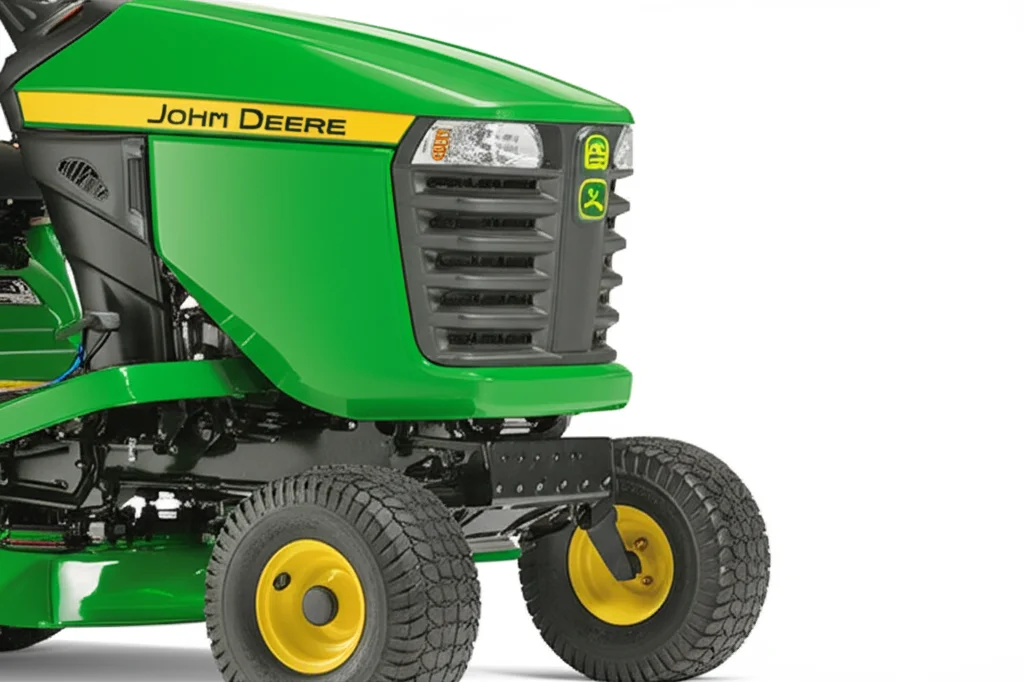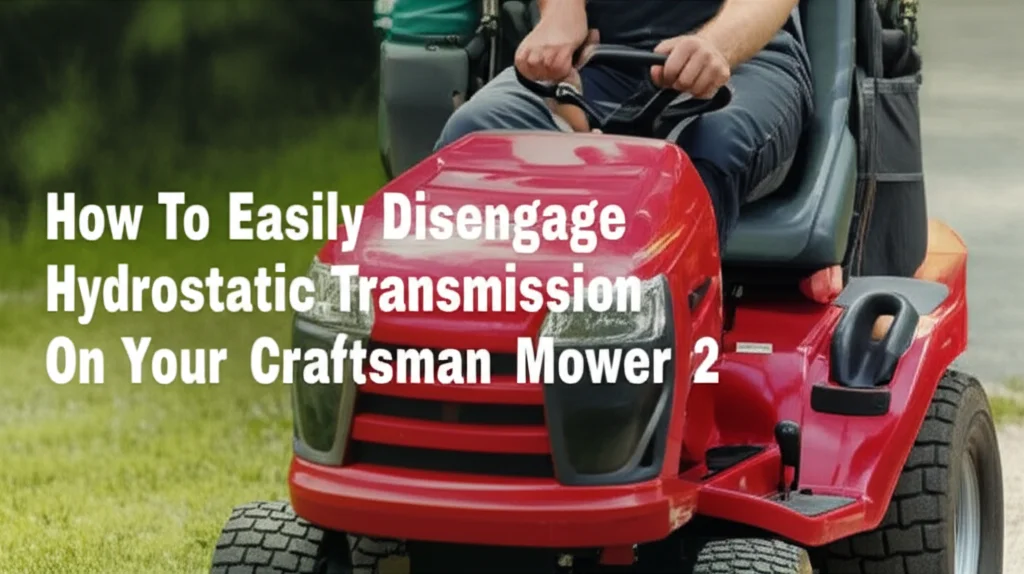· Lawn Mower Maintenance · 6 min read
How To Disengage Hydrostatic Transmission John Deere

Disengaging Your John Deere Hydrostatic Transmission: A Step-by-Step Guide
Have you ever needed to move your John Deere lawn tractor for maintenance, or perhaps tow it? Disengaging the hydrostatic transmission is crucial for safely performing these tasks. It prevents unexpected movement and allows for free wheeling. This article will walk you through the process, ensuring you can confidently disengage your John Deere’s transmission. We’ll cover everything from locating the bypass valve to understanding safety precautions.
Takeaway:
- Always consult your John Deere operator’s manual for model-specific instructions.
- Ensure the engine is OFF and the parking brake is engaged before attempting to disengage the transmission.
- Locate and operate the bypass valve to allow the wheels to turn freely.
- Re-engage the transmission before resuming normal operation.
Quick Answer:
To disengage a John Deere hydrostatic transmission, locate the bypass valve (usually near the transmission), turn off the engine, engage the parking brake, and then open the valve. This allows the wheels to rotate freely for towing or maintenance. Remember to close the valve and restart the engine before operating the tractor.
Understanding Your John Deere Hydrostatic Transmission
John Deere hydrostatic transmissions are known for their smooth operation and efficiency. They use hydraulic fluid to transfer power from the engine to the wheels, providing variable speed control. However, this system also means the wheels are constantly engaged when the engine is running. This is why disengaging the transmission is necessary for certain procedures. Understanding how this system works will help you appreciate the importance of proper disengagement. A properly maintained hydrostatic transmission will provide years of reliable service.
Locating the Hydrostatic Transmission Bypass Valve
The first step to disengaging your John Deere hydrostatic transmission is finding the bypass valve. This valve is typically located near the transmission itself, often underneath the tractor. Consult your John Deere operator’s manual – it will have a specific diagram for your model. The valve usually has a handle or knob that you need to turn. It’s often brightly colored, like red or yellow, to make it easily identifiable. Knowing the exact location saves time and prevents frustration.
Step-by-Step: How to Disengage the Transmission
Now that you’ve located the bypass valve, let’s walk through the disengagement process. Remember safety first!
- Turn Off the Engine: Completely shut down the engine and remove the key. This prevents accidental starting during the process.
- Engage the Parking Brake: Firmly set the parking brake. This is a critical safety step to prevent the tractor from rolling.
- Locate the Bypass Valve: Refer to your operator’s manual if needed.
- Open the Bypass Valve: Turn the handle or knob on the bypass valve. You should feel a distinct change as the valve opens. This releases the hydraulic pressure and allows the wheels to turn freely.
- Test for Free Wheeling: Gently try to push or roll the tractor. The wheels should move without resistance. If they don’t, double-check that the bypass valve is fully open.
For more information on disengaging transmissions on other brands, check out this guide on how to disengage hydrostatic transmission on your Craftsman mower.
Safety Precautions When Disengaging
Disengaging the hydrostatic transmission is a relatively simple process, but safety should always be your top priority. Always ensure the engine is off and the parking brake is firmly engaged. Never attempt to disengage the transmission while the engine is running. Be aware of your surroundings and ensure the area around the tractor is clear before attempting to move it. If you are unsure about any step, consult your John Deere operator’s manual or a qualified mechanic. Proper safety practices prevent accidents and ensure a smooth experience.
Re-Engaging the Hydrostatic Transmission
Once you’ve completed your maintenance or towing, re-engaging the transmission is just as important.
- Close the Bypass Valve: Turn the handle or knob on the bypass valve back to its original position. You should feel it click or lock into place.
- Start the Engine: Start the engine and allow it to warm up for a few minutes.
- Test the Drive System: Slowly engage the drive pedal to ensure the transmission is functioning correctly. Listen for any unusual noises.
- Verify Proper Operation: Drive the tractor slowly in both forward and reverse to confirm everything is working as expected.
Regular maintenance, like keeping your John Deere fuel tank clean, will help ensure your transmission operates smoothly.
Troubleshooting Common Issues
Sometimes, the bypass valve may be difficult to turn, or the wheels may not roll freely even after opening the valve. Here are a few common issues and how to address them:
- Stuck Bypass Valve: Apply penetrating oil to the valve stem and let it sit for a few minutes before attempting to turn it again.
- Wheels Still Engaged: Double-check that the bypass valve is fully open. If it is, there may be an issue with the transmission itself, requiring professional attention.
- Valve Handle Broken: Do not attempt to operate a broken valve. Contact a John Deere dealer for a replacement.
If you’re experiencing persistent transmission problems, it might be time to consider a hydrostatic transmission oil change or a professional inspection.
Frequently Asked Questions (FAQ)
Q: Can I disengage the transmission while the engine is running?
A: No, absolutely not. Disengaging the transmission while the engine is running is extremely dangerous. It can lead to unexpected movement and potential injury. Always turn off the engine and engage the parking brake first.
Q: Where can I find my John Deere operator’s manual?
A: You can usually find a digital copy of your operator’s manual on the John Deere website. Alternatively, a physical copy should have come with your tractor.
Q: What if the bypass valve is rusted and won’t turn?
A: Try applying penetrating oil and letting it sit for a while. If that doesn’t work, you may need to consult a mechanic. Do not force it, as you could break the valve.
Q: Is it normal for the wheels to feel slightly resistant even after disengaging the transmission?
A: A small amount of resistance is normal. However, the wheels should roll relatively freely. If there’s significant resistance, there may be an issue with the transmission.
Q: What should I do if I suspect a problem with my hydrostatic transmission?
A: If you suspect a problem, it’s best to consult a qualified John Deere mechanic. Ignoring transmission issues can lead to more significant and costly repairs down the road.
Conclusion
Disengaging your John Deere hydrostatic transmission is a straightforward process when you follow the correct steps. Remember to prioritize safety by always turning off the engine and engaging the parking brake. By understanding the location of the bypass valve and following the instructions in your operator’s manual, you can confidently perform maintenance or tow your tractor. Regular maintenance, like keeping your John Deere exhaust filter clean, will help ensure the longevity and smooth operation of your hydrostatic transmission. Don’t hesitate to seek professional help if you encounter any difficulties.
- hydrostatic transmission
- John Deere
- disengage transmission
- mower repair
- lawn tractor


